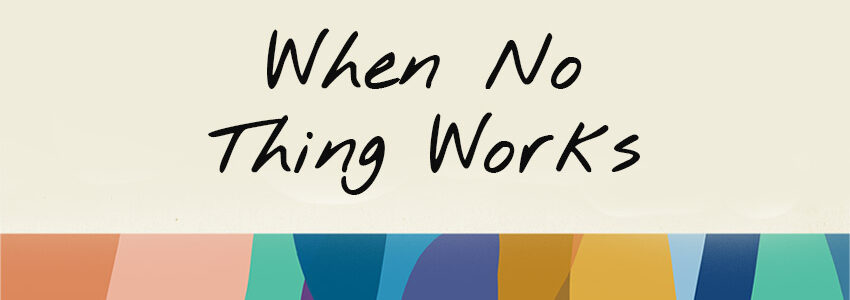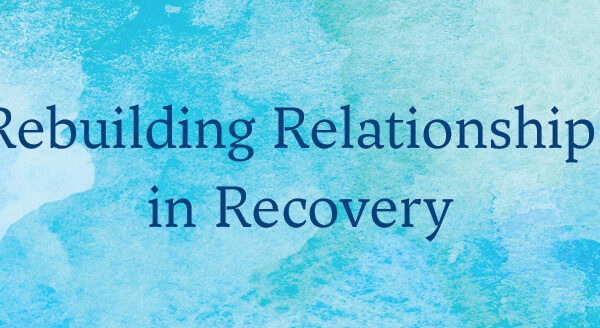
When No Thing Works Excerpt: Slipstream
Categories: Excerpt New Release Spirituality & Religion
There is a lot going on in the world. So much so that it feels like we are being pulled and pushed along, and the next moment, falling far behind. The energy and directional forces are change-inducing elements, in and of themselves. Having some understanding of the science of what it is we are feeling is useful in figuring out what to do in it and about it, how to take advantage of the gusty flow and, in effect, being purposefully in the slipstream.
According to Wikipedia, “A slipstream is a region behind a moving object in which a wake of fluid is moving at velocities comparable to that of the moving object, relative to the ambient fluid through which the object is moving. The term slipstream also applies to the similar region adjacent to an object with a fluid moving around it.”
Physicists talk about time as being more about relationships than constancy. Or at least that’s how a nonscientist may interpret what a physicist is saying in one of those articles in which a scientist patiently explains to a layperson the mysterious wonder of the universe. Time+place, or shorthanded timeplace, is how we experience the course of events in time and in place, across time and across places. When more things happen in a human-made measurable period of time, that feels like everything is speeding up and time itself is moving faster. Entirely inaccurate from the point of view of simple math, but not unheard of in the advanced algorithms of the continuously changing variableness of physics. We don’t need to understand the physics to have the felt experience.
In Finding Nemo, the protagonist’s father, Marlin, rides Crush the sea turtle on the fast-moving stream of the East Australian Current. Clocking in at about 4.4 miles per hour, this current isn’t even the fastest, believed to be the Gulf Stream, at 5.6 miles per hour. An Olympic swimmer can match this speed on a short sprint like the fifty-meter (0.03-mile) freestyle. In comparison, the cast of Finding Nemo could have, if they wished, traversed twelve thousand miles at the same speed as Michael Phelps, jetting along with far fewer flapping of fins.
The amazing aspect of ocean currents is that they exist above and below of, side by side with, the variable and slower movements of oceans. A vessel upon the ocean’s surface will be propelled or slowed down or directionally thwarted because of currents of energy miles wide, miles deep, and hundreds or thousands of miles long. The phenomenon is a vast force of nature, studied and utilized by mariners for thousands of years.
There is a lot going on in the world. While I sit on the floor typing these words to the tunes of HAPA, cat sleeping just out of sight, slight breeze visible in the leaves of the neighbor’s tree, one eye occasionally landing on the clock to make sure that I’m not late for my meeting . . . while I do these things, the personal bubble of timeplace moves deliberately apace in four-by-four time and I am swimming with easy strokes in shallow water toward shore, buoyed by the tide. At the same time, immeasurably gigantanormous stuff is happening all over the world—bustling, creating, growing, dying, inventing, destroying, monotonous burger flipping, raving, icebergs cleaving, drones targeting, some quiet scurrying through dark forest floors but mostly cacophonous pontification. More than ninety-five million Instagrams are sent each day. Though a single person can only view about 150 or so in that time, the impact of the millions roils on. 95M × 95M time.
There is a lot going on in the world, and it feels like even more is being stuffed into each moment. Urgently pushed or runaway momentum? Impact-wise, it doesn’t matter. We are in a swiftly moving current much of which has been created by humans and human actions over time and space. This phenomenon is short-handedly called collective acceleration.
To be clear, it is a made-up term—no scholarship, or science. (Although there is an electrical engineering term so named, there is no derivation to be made.) Collective acceleration is the short-handed description of the felt experience of living in the world during a time in which everything seems to be “going faster” so much so that it is better captured as “much more going much faster.” So many people in so many places across cultures, nationalities, social and economic circumstances, societal roles, ages, genders, and ideologies are in the felt whirl of this acceleration that we can confidently say: this is collective phenomena. Not all, of course, but enough to say: we feel this, we are dealing with this, we are affected by this. Not all, of course. The human emerging from a four-by-four rhythm cocoon of just a few weeks will likely be astonished by the storms that arrived and dissipated, the businesses that are merging or calling it quits, the deals made or fallen through, the laws overturned, the voices newly legitimized. Slip-ping out of the current doesn’t mean the current stops. Indeed, upon reentry, the point we left is now far downstream.
To be clear, this is far from the first collective acceleration moment in human history. These pivotal, cleaving moments are the proximate cause of one or more environmental, human conflict, human aspiration, technological, or economic upheavals or events.
Here we briefly talk about four upheaval-event categories: large-scale epidemics and pandemics, mass migrations, wars, and technological advances.
There have been many world-changing epidemics and pandemics. The Antonine Plague, AD 165–180, took five million lives. The Plague of Justinian, likely the bubonic plague, hit the Byzantine Empire, 541–549, claiming 10 percent of the world’s population. Fifty percent of Europe’s population were lost during the Black Death, caused by Yersinia pestis, 1346–1353. Viral hemorrhagic fever, the Cocoliztli Epidemic, took fifteen million lives in Mexico and Central America in the sixteenth century. During the same century, 90 percent of the Indigenous population of the Americas succumbed to a combination of illnesses imported by Europeans. In comparison, the COVID-19 pandemic has taken an estimated three million lives so far, about 4 percent of the world’s population.
Epidemics and pandemics. Massive disrupters of families, communities, health systems, the trajectories and the demise of entire peoples, altered immune systems that are passed to succeeding generations. Rapid decline of the labor force both disrupts and shifts economies including, mostly temporarily, the balance of power between those who labor and those who require labor. Inventions arise, especially in medicines, public health practices and ways. The institutions of the time—family, community, government, businesses, fraternal organizations, religious centers—arise to the need or fail to do so, each learning in the process and acting or reacting in temporary or permanent ways.
In the past, there have been numerous mass migrations. The ancestors of Polynesians—the many peoples of the islands of the Pacific—migrated from the coastal areas of south Asia around 1600 BC, 3,600 years ago. Polynesians continued to migrate, ending in populating Hawai‘i in AD 400. Among the largest forced migrations through capture, kidnapping, and slavery relocated between ten and twelve million people of the sub-Sahara to the Americas in the span of 360 years. Construction of the Three Gorges Dam in China, and related flooding, displaced 1.2 million people. The Potato Famine, 1.5 million. Nearly all of the Indigenous peoples in the lower forty-eight United States were forcibly relocated—forced internal migration. Their lands were largely occupied by European migrants, along with other parts of the Americas, parts of Africa and Australia, totaling about sixty million European migrants over four hundred years beginning in the 1600s. In current times, tens of thousands have fled the violence, unsustainable climate conditions, and poverty of Central America.
Migrations occur as people move away from and move toward. Moving away from sustained flooding, sustained droughts, violence and conflicts, overcrowded conditions, diminishing possibilities, and, in recent years, rising seas. Moving toward possibilities, safety, jobs, promises. Others are stolen, coerced, forced, driven out. If this were a political analysis, there would be a distinction between immigrants, migrants, refugees, and asylum seekers, and forced labor. Migrations change the course of the places people came from, and the places people traverse to. The size and time compression of mass migrations mean the impacts are identifiable and measurable and specific to those peoples, those times, those places. The dislocation of Indigenous peoples robbed subsequent generations of place-based wisdom. Migrants contribute to peoples and places. Migrations in and of themselves are sharp pivots. “That” used to be our life and future. Now “this” is our life and future, known and unknown.
There were and are the many wars. How many have there been? It is apparently easier to measure the amount of time when there were none. Defining war as a conflict that claims a thousand or more lives, Will and Ariel Durant in their Lessons of History (1968) estimated that only 8 percent of human history (which they conservatively measured as the past 3,400 years, a more West-ern perspective of civilization, editorially speaking) has been without war. We tend to see the armed conflicts that are in the news. Can you guess how many conflicts claimed over a thousand lives in 2021–2022? Sixteen armed conflicts claimed over a thousand lives, two of which have claimed over ten thousand lives (Myanmar civil war and Russo-Ukrainian War). Can you name at least half of these conflicts? Chances, no. No war ends wars.
The many wars disrupt and displace. They uniformly destroy place, both human-made and environmentally born. Wars perversely destroy economies while supercharging industrial complexes, simultaneously feeding jobs while displacing livelihoods. Health care usually improves post-conflict because of wartime learnings, but these improvements mostly accrue to countries with intact infrastructure and the means to adopt and distribute. Wars divert and devour resources: humans, money, raw materials, intellectual capital, goodwill.
The technology discoveries of one era become the floor of what’s possible and define the aspirations of a society, and some-times a generation and a civilization. Without the discovery of boats some ten thousand years ago, fishing would have remained a subsistence practice, trade limited to regional bartering, and human migration, well, not a thing. The invention of papermaking in the second century marked the beginning of large-scale and portable knowledge transfer and communication uncoupled from oral history and human memory. Arguably, the Industrial Revolution would not have been possible without the discovery and harnessing of electricity—powered by whatever means, not only to power industry but also to power the discovery of other technologies. About 65 percent of the world’s population are too young to know a world without the all-pervasive internet, and it will be close to zero in a mere fifty years. But 37 percent of the world’s population don’t use the internet, mostly due to access issues defined by poverty and proximity to infrastructure, which in turn impact access to information and basic services that are increasingly only available through internet-related technology. The triggering of the immune system within our own bodies with a replicable protein would not have been possible without the technological breakthrough of mRNA, which is estimated to have prevented between ten and fourteen million deaths from COVID-19.
As these few examples show, technology has had a profound and frequently “sudden” impact on the trajectory of human events since the beginning of human events.
And here we are.
Here we are in the convergence of global environmental phenomena, collapsing economies, mass migration.
Warming oceans, disappearing lakes, stronger hurricanes, droughts, wildfires, floods, the demise of species. Insolvent governments, the thinning fortunes of the global middle class, gross wealth accruing to an elite few, sharp decline of global extreme poverty, steady increase in the ranks of the working poor, labor shortages, stretched supply lines. The hardening and collapse of national borders as countries struggle to manage refugees, asylum seekers, migrants that don’t quite meet one legal category or another but nonetheless are fleeing the collapse and chaos of their home states, a steadily increasing stream with sudden surges fueled by wars.
Whew!
If you google the phrase “may you live in interesting times,” among the subjects that will pop up is “what are some curse words in Chinese.” There are also claims that the phrase “may you live in interesting times,” thought to be ancient Chinese in origin, is really a modern Western notion. Without going down a rabbit hole (with apologies to rabbits), consider that the Chi-nese word for “crisis” includes the word 机. 机 is part of the word for “opportunity,” but by itself is more accurately described as a critical juncture when and where change begins. Contextually, the ancient wisdom of this is that there can be no big leaps without risk and the presence of the unknown.
This accelerating time of convergence is a time in which crisis is omnipresent. The collapse of all things feels imminent. We feel it because it is impossible for there to be such turmoil on the ground and in the universe itself without great waves of energy, or perhaps the energy is created by the internal turmoil we feel. Both are probably true, which magnifies the signature and momentum of this great current moving through the timeplace.
On August 8, 2023, Hurricane Dora tracked south of the Hawaiian Islands, bringing strong gusts of wind and very little rain. A series of wildfires erupted in drought-stricken pockets, and calamitous fires clocked at a mile per minute consumed the town of Lahaina. Too many lives lost. Homes destroyed. Thousands displaced. The land now holds nearly unbearable pain. In this placetime of tragedy, what can be said about possibility? And yet, before the ash had settled, humanity immediately arose in self-organized pods to provide food, supplies, clothes, comfort, aloha for neighbors and those-we-have-only-recently-met, well before and with more ingenuity than the overwhelmed govern-ments. People from across the islands and indeed many places beyond focused their attention on supporting those who were supporting many. Within a few months, the bubbling up of critical questions and ideas on how to not return to the flaws and fractures of pre-wildfire Maui unsettles the established power dynamic and heralds, perhaps, a new way forward. A consuming fire is both a tragedy and a critical juncture for change that will inspire many. If the juncture is ignored or swept aside, if we step away rather than step in, then it is only a disastrous tragedy.
Thus, seen and felt, herein lies 机, the critical juncture for entering the pathway of the current. 机 is the threshold between the chaos of collective acceleration and entering the slipstream. While we may hesitate, not knowing many things, it is the unknown that holds the most powerful possibilities. So take a breath. Take a step.




